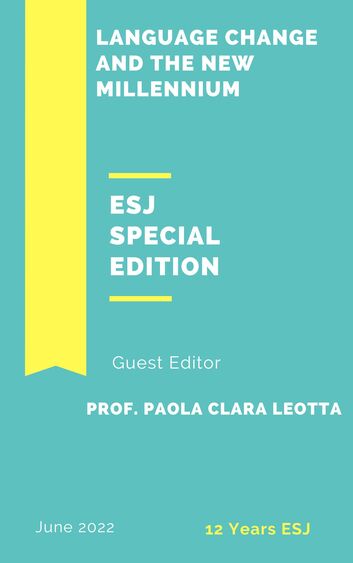Language Change, New Millennium, and the Watershed in the Use of English
Abstract
We all agree that language, like any living being, undergoes constant change and evolution to adapt to the needs of its users. Therefore, the English Language being a Lingua Franca is not an exception, and it keeps pace more than other languages in the world with cutting edge developments in all areas of human life with its primary function of effective communication in professional as well as ordinary real-life situations. The development of English as an International Language has become more noticeable since the beginning of globalization. Furthermore, it leads to the definition of Global English(es) and is even more vivid after digitalization in which its significant role and existential function are now unquestionable. Moreover, it is the best communication tool for global citizens, individuals equipped with 21st century skills uniting under one common goal of making the world a better place to live via sharing and exchanging knowledge and expertise, as well as collaborating and cooperating more than ever before, using this powerful weapon connecting us all - English. With this thematic literature review, based on synchronic and diachronic linguistics, the two authors reconstruct and highlight expeditious changes and turning points undergone by the English Language, especially during the COVID-19 pandemic. In the conclusion, a summary of the key findings taken from the literature were given, and their significance were emphasised, as many changes in vocabulary are in order (abbreviations, simultaneous conversations, new uses, new structures, popularised health communication), especially in how they reflect a new language need to express the dynamism of current global challenges.
Downloads
Metrics
PlumX Statistics
References
2. AbuSa’aleek Atef Odeh (2015). Internet Linguistics: A Linguistic Analysis of Electronic Discourse as a New Variety of Language; Published at the International Journal of English Linguistics; Vol. 5, No. 1; 2015 ISSN 1923-869X E-ISSN 1923-8703 Published by Canadian Center of Science and Education.
3. Aitchison, J. (2011). The Articulate Mammal. An Introduction to Psycholinguistics. Routledge.
4. Baldry, A. & Thibault, P. J. (2006). Multimodal Transcription and Text Analysis: A Multimedia Toolkit and Coursebook, Sheffield, Equinox.
5. Calsamiglia, H. & Van Dijk, A. (2004). Popularization Discourse and Knowledge about the Genome, Discourse & Society 15, 369-389.
6. Collot, M. & Belmore, N. (1996). A New Variety of English. Computer-mediated communication: Linguistic, social, and cross-cultural perspectives, 39, 13.7
7. Crystal, D. (2003). A Dictionary of Linguistics and Phonetics (5th ed.). Oxford: Blackwell.
8. Crystal, D. (2006). Language and the Internet (2nd ed.). Cambridge: Cambridge University.
http://dx.doi.org/10.1017/CBO9780511487002
9. Crystal, D. (2008). Txting: The gr8 db8. Oxford: Oxford University Press.
10. Davis, B. H. & Brewer, J. (1997). Electronic discourse: Linguistic individuals in virtual space. Suny Press.
11. De Saussure, F., Bally, C., Sechehaye, A., & Riedlinger, A. (1916). Cours de linguistique Générale, Italian Edition Laterza 2009.
12. Galloway, N. & Numajiri, T. (2020). Global Englishes Language Teaching: Bottom-up Curriculum Implementation, Tesol Quarterly 54 (1), 118-145.
13. Graddol, D. (1997). The future of English: A guide to forecasting the popularity of the English language in the 21st century. London: British Council.https://englishlive.ef.com/blog/english-in-the-real-world/english-became-global-language/
14. Herring, S. C. (Ed.). (1996). Computer-mediated communication: Linguistic, social and cross-cultural perspectives. Amsterdam: John Benjamins. http://dx.doi.org/10.1075/pbns.39
15. Kachru, B. B. (1985). Standards, codification, and sociolinguistic realism: The English language in the outer circle. In: Quirk, R. and H. Widdowson, (eds.) English in the World: Teaching and Learning the language and the literature. Cambridge: Cambridge University Press.
16. Kirkpatrick, A. (2007). World Englishes: Implications for International communication and English language teaching. Cambridge: Cambridge University Press.
17. Kreuz, R. (2020). How COVID-19 is changing the English language, website https://theconversation.com/how-covid-19-is-changing-the-english-language-146171/, https://www.fastcompany.com/90556360/how-covid-19-is-changing-the-english-language;
18. Kreuz, R. (2020). ‘The pandemic is changing the English language’; website (https://edition.cnn.com/2020/10/16/health/english-language-changing-coronavirus-wellness-partner/index.html);
19. Lee, L. (2002). Synchronous online exchanges: A study of modification devices on non-native discourse interaction. System, 30, 275-288. http://dx.doi.org/10.1016/S0346-251X(02)00015-5
20. Lee, L. (2009). Using wikis, blogs and podcasts in the foreign language classroom: A task-based approach. In L. Stone & C. Wilson-Duffy (Eds.), Task-based III: Expanding the range of tasks with online resources (pp.49-70). International Association for Language Learning Technology.
21. Macfadyen, L. P., Roche, J., & Doff, S. (2004). Communicating across cultures in cyberspace (Vol. 2). New Brunswick and London: Transaction Publishers.
22. Moirand, S. (1997). Formes discursives de la diffusion des savoirs dans les medias, Hermès, 21, 33-34.
23. Muniandy, A. V. (2002). Electronic discourse (E-discourse): Spoken, written or a new hybrid? PROSPECT-ADELAIDE-, 17(3), 45-68.
24. Nida, E. (1964). Toward a Science of Translating, Leiden, Brill;
25. Nielsen, P. M. (2020). The English Language in the 21st century. Different Identities of a “Global Language”, Ideas, I, 1, 89-94.
26. Pop, L. (2008). Ce qui reste des relations de discours en cyberl@ ngue. Recherches ACLIF: Actes du Séminaire de Didactique Universitaire, (05), 130-144.
27. Sokol, M. (2018). Have you wondered why sportspeople die? The medical weblog as a popularization tool, Discourse, Context & Media 25, 13-24.
28. Soria, C. (2016). What Is Digital Language Diversity And Why Should We Care?, Linguapax Review, 13-28.
29. Tagliamonte, S. & Denis, D. (2008). Linguistic ruin? LOL! Instant messaging and teen language. American Speech, 83, 3-34. http://dx.doi.org/10.1215/00031283-2008-001
30. Thurlow, C. & Brown, A. (2003). Generation txt? The sociolinguistics of young people's text-messaging. Discourse Analysis Online, 1, 1-27. Retrieved November 1, 2014, from http://faculty.washington.edu/thurlow/papers/Thurlow(2003)-DAOL.pdf
31. Thurlow, C. (2001). The Internet and language. In R. Mesthrie & R. Asher (Eds.), Concise Encyclopaedia of Sociolinguistics (pp. 287-289).
32. Toyoda, E. & Harrison, R. (2002). Categorization of text chat communication between learners and native speakers of Japanese. Language Learning & Technology, 6, 82-99. Retrieved from http://llt.msu.edu/vol6num1/toyoda/
33. Trittin-Ulbrich, H., Scherer, A. G., Munro, I. & Whelan, G. (2020). Exploring the dark and unexpected sides of digitalization: Toward a critical agenda, Dark Sides of Digitalization, 28(1), 8–25 https://journals.sagepub.com/doi/pdf/10.1177/1350508420968184
34. https://www.youtube.com/watch?v=MqqlSb9uGUQ (Full Circle & David Crystal: The Future of Englishes, 2015)
35. https://www.youtube.com/watch?v=s-U40_PdBcw (David Crystal - Internet Linguistics, 10 August 2021)
Copyright (c) 2022 Paola Clara Leotta, Tamari Dolidze

This work is licensed under a Creative Commons Attribution-NonCommercial-NoDerivatives 4.0 International License.








